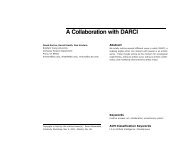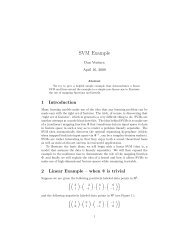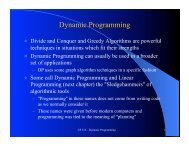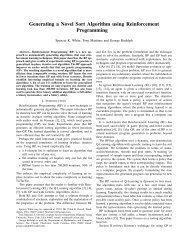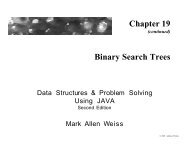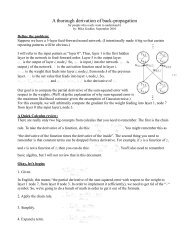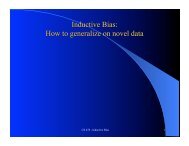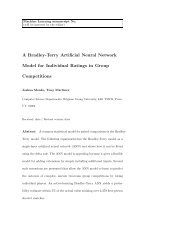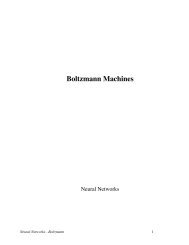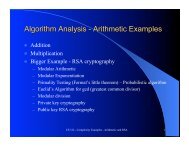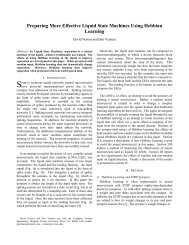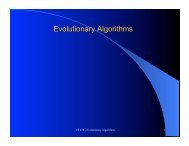RBM Training Notes - Neural Network and Machine Learning ...
RBM Training Notes - Neural Network and Machine Learning ...
RBM Training Notes - Neural Network and Machine Learning ...
- No tags were found...
You also want an ePaper? Increase the reach of your titles
YUMPU automatically turns print PDFs into web optimized ePapers that Google loves.
Department of Computer Science6 King’s College Rd, TorontoUniversity of TorontoM5S 3G4, Canadahttp://learning.cs.toronto.edu fax: +1 416 978 1455Copyright c Geoffrey Hinton 2010.August 2, 2010UTML TR 2010–003A Practical Guide to <strong>Training</strong>Restricted Boltzmann <strong>Machine</strong>sVersion 1Geoffrey HintonDepartment of Computer Science, University of Toronto
A Practical Guide to <strong>Training</strong> Restricted Boltzmann<strong>Machine</strong>sVersion 1Geoffrey HintonDepartment of Computer Science, University of TorontoContents1 Introduction 32 An overview of Restricted Boltzmann <strong>Machine</strong>s <strong>and</strong> Contrastive Divergence 33 How to collect statistics when using Contrastive Divergence 53.1 Updating the hidden states . . . . . . . . . . . . . . . . . . . . . . . . . . . . . . . . . 53.2 Updating the visible states . . . . . . . . . . . . . . . . . . . . . . . . . . . . . . . . . 63.3 Collecting the statistics needed for learning . . . . . . . . . . . . . . . . . . . . . . . . 63.4 A recipe for getting the learning signal for CD 1 ...................... 64 The size of a mini-batch 64.1 A recipe for dividing the training set into mini-batches . . . . . . . . . . . . . . . . . . 75 Monitoring the progress of learning 75.1 A recipe for using the reconstruction error . . . . . . . . . . . . . . . . . . . . . . . . . 76 Monitoring the overfitting 86.1 A recipe for monitoring the overfitting . . . . . . . . . . . . . . . . . . . . . . . . . . . 87 The learning rate 87.1 A recipe for setting the learning rates for weights <strong>and</strong> biases . . . . . . . . . . . . . . . 88 The initial values of the weights <strong>and</strong> biases 98.1 A recipe for setting the initial values of the weights <strong>and</strong> biases . . . . . . . . . . . . . 99 Momentum 91
9.1 A recipe for using momentum . . . . . . . . . . . . . . . . . . . . . . . . . . . . . . . . 1010 Weight-decay 1010.1 A recipe for using weight-decay . . . . . . . . . . . . . . . . . . . . . . . . . . . . . . . 1111 Encouraging sparse hidden activities 1111.1 A recipe for sparsity . . . . . . . . . . . . . . . . . . . . . . . . . . . . . . . . . . . . . 1212 The number of hidden units 1212.1 A recipe for choosing the number of hidden units . . . . . . . . . . . . . . . . . . . . . 1213 Different types of unit 1313.1 Softmax <strong>and</strong> multinomial units . . . . . . . . . . . . . . . . . . . . . . . . . . . . . . . 1313.2 Gaussian visible units . . . . . . . . . . . . . . . . . . . . . . . . . . . . . . . . . . . . 1313.3 Gaussian visible <strong>and</strong> hidden units . . . . . . . . . . . . . . . . . . . . . . . . . . . . . . 1413.4 Binomial units . . . . . . . . . . . . . . . . . . . . . . . . . . . . . . . . . . . . . . . . 1413.5 Rectified linear units . . . . . . . . . . . . . . . . . . . . . . . . . . . . . . . . . . . . . 1414 Varieties of contrastive divergence 1515 Displaying what is happening during learning 1616 Using <strong>RBM</strong>’s for discrimination 1616.1 Computing the free energy of a visible vector . . . . . . . . . . . . . . . . . . . . . . . 1717 Dealing with missing values 1711 If you make use of this technical report to train an <strong>RBM</strong>, please cite it in any resulting publication.2
1 IntroductionRestricted Boltzmann machines (<strong>RBM</strong>s) have been used as generative models of many differenttypes of data including labeled or unlabeled images (Hinton et al., 2006a), windows of mel-cepstralcoefficients that represent speech (Mohamed et al., 2009), bags of words that represent documents(Salakhutdinov <strong>and</strong> Hinton, 2009), <strong>and</strong> user ratings of movies (Salakhutdinov et al., 2007). In theirconditional form they can be used to model high-dimensional temporal sequences such as video ormotion capture data (Taylor et al., 2006) or speech (Mohamed <strong>and</strong> Hinton, 2010). Their mostimportant use is as learning modules that are composed to form deep belief nets (Hinton et al.,2006a).<strong>RBM</strong>s are usually trained using the contrastive divergence learning procedure (Hinton, 2002).This requires a certain amount of practical experience to decide how to set the values of numericalmeta-parameters such as the learning rate, the momentum, the weight-cost, the sparsity target, theinitial values of the weights, the number of hidden units <strong>and</strong> the size of each mini-batch. There are alsodecisions to be made about what types of units to use, whether to update their states stochasticallyor deterministically, how many times to update the states of the hidden units for each training case,<strong>and</strong> whether to start each sequence of state updates at a data-vector. In addition, it is useful to knowhow to monitor the progress of learning <strong>and</strong> when to terminate the training.For any particular application, the code that was used gives a complete specification of all ofthese decisions, but it does not explain why the decisions were made or how minor changes will affectperformance. More significantly, it does not provide a novice user with any guidance about how tomake good decisions for a new application. This requires some sensible heuristics <strong>and</strong> the ability torelate failures of the learning to the decisions that caused those failures.Over the last few years, the machine learning group at the University of Toronto has acquiredconsiderable expertise at training <strong>RBM</strong>s <strong>and</strong> this guide is an attempt to share this expertise withother machine learning researchers. We are still on a fairly steep part of the learning curve, so theguide is a living document that will be updated from time to time <strong>and</strong> the version number shouldalways be used when referring to it.2 An overview of Restricted Boltzmann <strong>Machine</strong>s <strong>and</strong> ContrastiveDivergenceSkip this section if you already know about <strong>RBM</strong>sConsider a training set of binary vectors which we will assume are binary images for the purposesof explanation. The training set can be modeled using a two-layer network called a “RestrictedBoltzmann <strong>Machine</strong>” (Smolensky, 1986; Freund <strong>and</strong> Haussler, 1992; Hinton, 2002) in which stochastic,binary pixels are connected to stochastic, binary feature detectors using symmetrically weightedconnections. The pixels correspond to “visible” units of the <strong>RBM</strong> because their states are observed;the feature detectors correspond to “hidden” units. A joint configuration, (v, h) of the visible <strong>and</strong>hidden units has an energy (Hopfield, 1982) given by:E(v, h) =−i∈visiblea i v i −j∈hiddenb j h j − i,jv i h j w ij (1)where v i ,h j are the binary states of visible unit i <strong>and</strong> hidden unit j, a i ,b j are their biases <strong>and</strong> w ij isthe weight between them. The network assigns a probability to every possible pair of a visible <strong>and</strong> a3
hidden vector via this energy function:p(v, h) = 1 Z e−E(v,h) (2)where the “partition function”, Z, is given by summing over all possible pairs of visible <strong>and</strong> hiddenvectors:Z = e −E(v,h) (3)v,hThe probability that the network assigns to a visible vector, v, is given by summing over all possiblehidden vectors:p(v) = 1 e −E(v,h) (4)ZThe probability that the network assigns to a training image can be raised by adjusting the weights<strong>and</strong> biases to lower the energy of that image <strong>and</strong> to raise the energy of other images, especially thosethat have low energies <strong>and</strong> therefore make a big contribution to the partition function. The derivativeof the log probability of a training vector with respect to a weight is surprisingly simple.h∂ log p(v)∂w ij= v i h j data−v i h j model(5)where the angle brackets are used to denote expectations under the distribution specified by thesubscript that follows. This leads to a very simple learning rule for performing stochastic steepestascent in the log probability of the training data:where is a learning rate.∆w ij = (v i h j data−v i h j model) (6)Because there are no direct connections between hidden units in an <strong>RBM</strong>, it is very easy to getan unbiased sample of v i h j data. Given a r<strong>and</strong>omly selected training image, v, the binary state, h j ,of each hidden unit, j, is set to 1 with probabilityp(h j =1| v) =σ(b j + iv i w ij ) (7)where σ(x) is the logistic sigmoid function 1/(1 + exp(−x)). v i h j is then an unbiased sample.Because there are no direct connections between visible units in an <strong>RBM</strong>, it is also very easy toget an unbiased sample of the state of a visible unit, given a hidden vectorp(v i =1| h) =σ(a i + jh j w ij ) (8)Getting an unbiased sample of v i h j model, however, is much more difficult. It can be done bystarting at any r<strong>and</strong>om state of the visible units <strong>and</strong> performing alternating Gibbs sampling for a verylong time. One iteration of alternating Gibbs sampling consists of updating all of the hidden unitsin parallel using equation 7 followed by updating all of the visible units in parallel using equation 8.A much faster learning procedure was proposed in Hinton (2002). This starts by setting thestates of the visible units to a training vector. Then the binary states of the hidden units are allcomputed in parallel using equation 7. Once binary states have been chosen for the hidden units,4
a “reconstruction” is produced by setting each v i to 1 with a probability given by equation 8. Thechange in a weight is then given by∆w ij = (v i h j data−v i h j recon) (9)A simplified version of the same learning rule that uses the states of indivisdual units instead ofpairwise products is used for the biases.The learning works well even though it is only crudely approximating the gradient of the log probabilityof the training data (Hinton, 2002). The learning rule is much more closely approximating thegradient of another objective function called the Contrastive Divergence (Hinton, 2002) which is thedifference between two Kullback-Liebler divergences, but it ignores one tricky term in this objectivefunction so it is not even following that gradient. Indeed, Sutskever <strong>and</strong> Tieleman have shown that itis not following the gradient of any function (Sutskever <strong>and</strong> Tieleman, 2010). Nevertheless, it workswell enough to achieve success in many significant applications.<strong>RBM</strong>s typically learn better models if more steps of alternating Gibbs sampling are used beforecollecting the statistics for the second term in the learning rule, which will be called the negativestatistics. CD n will be used to denote learning using n full steps of alternating Gibbs sampling.3 How to collect statistics when using Contrastive DivergenceTo begin with, we shall assume that all of the visible <strong>and</strong> hidden units are binary. Other types ofunits will be discussed in sections 13. We shall also assume that the purpose of the learning is tocreate a good generative model of the set of training vectors. When using <strong>RBM</strong>s to learn Deep BeliefNets (see the article on Deep Belief <strong>Network</strong>s at www.scholarpedia.org) that will subsequently befine-tuned using backpropagation, the generative model is not the ultimate objective <strong>and</strong> it may bepossible to save time by underfitting it, but we will ignore that here.3.1 Updating the hidden statesAssuming that the hidden units are binary <strong>and</strong> that you are using CD 1 , the hidden units should havestochastic binary states when they are being driven by a data-vector. The probability of turning onahiddenunit,j, is computed by applying the logistic function σ(x) =1/(1 + exp(−x)) to its “totalinput”:p(h j = 1) = σ(b j + v i w ij ) (10)i<strong>and</strong> the hidden unit turns on if this probability is greater than a r<strong>and</strong>om number uniformly distributedbetween 0 <strong>and</strong> 1.It is very important to make these hidden states binary, rather than using the probabilitiesthemselves. If the probabilities are used, each hidden unit can communicate a real-value to thevisible units during the reconstruction. This seriously violates the information bottleneck created bythe fact that a hidden unit can convey at most one bit (on average). This information bottleneckacts as a strong regularizer.For the last update of the hidden units, it is silly to use stochastic binary states because nothingdepends on which state is chosen. So use the probability itself to avoid unnecessary sampling noise.When using CD n , only the final update of the hidden units should use the probability.5
3.2 Updating the visible statesAssuming that the visible units are binary, the correct way to update the visible states when generatinga reconstruction is to stochastically pick a 1 or 0 with a probability determined by the total top-downinput:p i = p(v i = 1) = σ(a i + h j w ij ) (11)jHowever, it is common to use the probability, p i , instead of sampling a binary value. This is notnearly as problematic as using probabilities for the data-driven hidden states <strong>and</strong> it reduces samplingnoise thus allowing faster learning. There is some evidence that it leads to slightly worse densitymodels (Tijmen Tieleman, personal communication, 2008). This probably does not matter whenusing an <strong>RBM</strong> to pretrain a layer of hidden features for use in a deep belief net.3.3 Collecting the statistics needed for learningAssuming that the visible units are using real-valued probabilities instead of stochastic binary values,there are two sensible ways to collect the positive statistics for the connection between visible unit i<strong>and</strong> hidden unit j:p i h j dataor p i p j datawhere p j is a probability <strong>and</strong> h j is a binary state that takes value 1 with probability p j . Using h jis closer to the mathematical model of an <strong>RBM</strong>, but using p j usually has less sampling noise whichallows slightly faster learning 2 .3.4 A recipe for getting the learning signal for CD 1When the hidden units are being driven by data, always use stochastic binary states. When they arebeing driven by reconstructions, always use probabilities without sampling.Assuming the visible units use the logistic function, use real-valued probabilities for both the data<strong>and</strong> the reconstructions 3 .When collecting the pairwise statistics for learning weights or the individual statistics for learningbiases, use the probabilities, not the binary states, <strong>and</strong> make sure the weights have r<strong>and</strong>om initialvalues to break symmetry.4 The size of a mini-batchIt is possible to update the weights after estimating the gradient on a single training case, but it isoften more efficient to divide the training set into small “mini-batches” of 10 to 100 cases 4 . Thisallows matrix-matrix multiplies to be used which is very advantageous on GPU boards or in Matlab.2 Using h j always creates more noise in the positive statistics than using p j but it can actually create less noise inthe difference of the positive <strong>and</strong> negative statistics because the negative statistics depend on the binary decision forthe state of j that is used for creating the reconstruction. The probability of j when driven by the reconstruction ishighly correlated with the binary decision that was made for j when it was driven by the data.3 So there is nothing r<strong>and</strong>om about the generation of the reconstructions given the binary states of the hidden units.4 The word “batch” is confusing <strong>and</strong> will be avoided because when it is used to contrast with “on-line” it usuallymeans the entire training set.6
To avoid having to change the learning rate when the size of a mini-batch is changed, it is helpfulto divide the total gradient computed on a mini-batch by the size of the mini-batch, so when talkingabout learning rates we will assume that they multiply the average, per-case gradient computed ona mini-batch, not the total gradient for the mini-batch.It is a serious mistake to make the mini-batches too large when using stochastic gradient descent.Increasing the mini-batch size by a factor of N leads to a more reliable gradient estimate but it doesnot increase the maximum stable learning rate by a factor of N, so the net effect is that the weightupdates are smaller per gradient evaluation 5 .4.1 A recipe for dividing the training set into mini-batchesFor datasets that contain a small number of equiprobable classes, the ideal mini-batch size is oftenequal to the number of classes <strong>and</strong> each mini-batch should contain one example of each class to reducethe sampling error when estimating the gradient for the whole training set from a single mini-batch.For other datasets, first r<strong>and</strong>omize the order of the training examples then use minibatches of sizeabout 10.5 Monitoring the progress of learningIt is easy to compute the squared error between the data <strong>and</strong> the reconstructions, so this quantityis often printed out during learning. The reconstruction error on the entire training set should fallrapidly <strong>and</strong> consistently at the start of learning <strong>and</strong> then more slowly. Due to the noise in thegradient estimates, the reconstruction error on the individual mini-batches will fluctuate gently afterthe initial rapid descent. It may also oscillate gently with a period of a few mini-batches when usinghigh momentum (see section 9).Although it is convenient, the reconstruction error is actually a very poor measure of the progress oflearning. It is not the function that CD n learning is approximately optimizing, especially for n>>1,<strong>and</strong> it systematically confounds two different quantities that are changing during the learning. Thefirst is the difference between the empirical distribution of the training data <strong>and</strong> the equilibriumdistribution of the <strong>RBM</strong>. The second is the mixing rate of the alternating Gibbs Markov chain. Ifthe mixing rate is very low, the reconstruction error will be very small even when the distributions ofthe data <strong>and</strong> the model are very different. As the weights increase the mixing rate falls, so decreasesin reconstruction error do not necessarily mean that the model is improving <strong>and</strong>, conversely, smallincreases do not necessarily mean the model is getting worse. Large increases, however, are a bad signexcept when they are temporary <strong>and</strong> caused by changes in the learning rate, momentum, weight-costor sparsity meta-parameters.5.1 A recipe for using the reconstruction errorUse it but don’t trust it. If you really want to know what is going on during the learning, use multiplehistograms <strong>and</strong> graphic displays as described in section 15. Also consider using Annealed Importance5 The easy way to parallelize the learning on a cluster is to divide each mini-batch into sub-mini-batches <strong>and</strong> to usedifferent cores to compute the gradients on each sub-mini-batch. The gradients computed by different cores must thenbe combined. To minimize the ratio of communication to computation, it is tempting to make the sub-mini-batcheslarge. This usually makes the learning much less efficient, thus wiping out much of the gain achieved by using multiplecores (Vinod Nair, personal communication, 2007).7
Sampling (Salakhutdinov <strong>and</strong> Murray, 2008) to estimate the density on held out data. If you arelearning a joint density model of labelled data (see section 16), consider monitoring the discriminativeperformance on the training data <strong>and</strong> on a held out validation set.6 Monitoring the overfittingWhen learning a generative model, the obvious quantity to monitor is the probability that the currentmodel assigns to a datapoint. When this probability starts to decrease for held out validation data, itis time to stop learning. Unfortunately, for large <strong>RBM</strong>s, it is very difficult to compute this probabilitybecause it requires knowledge of the partition function. Nevertheless, it is possible to directly monitorthe overfitting by comparing the free energies of training data <strong>and</strong> held out validation data. In thiscomparison, the partition function cancels out. The free energy of a data vector can be computed ina time that is linear in the number of hidden units (see section 16.1). If the model is not overfittingat all, the average free energy should be about the same on training <strong>and</strong> validation data. As themodel starts to overfit the average free energy of the validation data will rise relative to the averagefree energy of the training data <strong>and</strong> this gap represents the amount of overfitting 6 .6.1 A recipe for monitoring the overfittingAfter every few epochs, compute the average free energy of a representative subset of the trainingdata <strong>and</strong> compare it with the average free energy of a validation set. Always use the same subset ofthe training data. If the gap starts growing, the model is overfitting, though the probability of thetraining data may be growing even faster than the gap, so the probability of the validation data maystill be improving. Make sure that the same weights are used when computing the two averages thatyou wish to compare.7 The learning rateIf the learning rate is much too large, the reconstruction error usually increases dramatically <strong>and</strong> theweights may explode.If the learning rate is reduced while the network is learning normally, the reconstruction errorwill usually fall significiantly. This is not necessarily a good thing. It is due, in part, to the smallernoise level in the stochastic weight updates <strong>and</strong> it is generally accompanied by slower learning inthe long term. Towards the end of learning, however, it typically pays to decrease the learning rate.Averaging the weights across several updates is an alternative way to remove some of the noise fromthe final weights.7.1 A recipe for setting the learning rates for weights <strong>and</strong> biasesA good rule of thumb for setting the learning rate (Max Welling, personal communication, 2002) isto look at a histogram of the weight updates <strong>and</strong> a histogram of the weights. The updates shouldbe about 10 −3 times the weights (to within about an order of magnitude). When a unit has a very6 The average free energies often change by large amounts during learning <strong>and</strong> this means very little because the logpartition function also changes by large amounts. It is only differences in free energies that are easy to interpret withoutknowing the partition function.8
large fan-in, the updates should be smaller since many small changes in the same direction can easilyreverse the sign of the gradient. Conversely, for biases, the updates can be bigger.8 The initial values of the weights <strong>and</strong> biasesThe weights are typically initialized to small r<strong>and</strong>om values chosen from a zero-mean Gaussian witha st<strong>and</strong>ard deviation of about 0.01. Using larger r<strong>and</strong>om values can speed the initial learning, butit may lead to a slightly worse final model. Care should be taken to ensure that the initial weightvalues do not allow typical visible vectors to drive the hidden unit probabilities very close to 1 or 0as this significantly slows the learning. If the statistics used for learning are stochastic, the initialweights can all be zero since the noise in the statistics will make the hidden units become differentfrom one another even if they all have identical connectivities.It is usually helpful to initialize the bias of visible unit i to log[p i /(1−p i )] where p i is the proportionof training vectors in which unit i is on. If this is not done, the early stage of learning will use thehidden units to make i turn on with a probability of approximately p i .When using a sparsity target probability of t (see section 11), it makes sense to initialize thehidden biases to be log[t/(1 − t)]. Otherwise, initial hidden biases of 0 are usually fine. It is alsopossible to start the hidden units with quite large negative biases of about −4 as a crude way ofencouraging sparsity.8.1 A recipe for setting the initial values of the weights <strong>and</strong> biasesUse small r<strong>and</strong>om values for the weights chosen from a zero-mean Gaussian with a st<strong>and</strong>ard deviationof 0.01. Set the hidden biases to 0. Set the visible biases to log[p i /(1 − p i )] where p i is the proportionof training vectors in which unit i is on. Look at the activities of the hidden units occasionally tocheck that they are not always on or off.9 MomentumMomentum is a simple method for increasing the speed of learning when the objective functioncontains long, narrow <strong>and</strong> fairly straight ravines with a gentle but consistent gradient along the floorof the ravine <strong>and</strong> much steeper gradients up the sides of the ravine. The momentum method simulatesa heavy ball rolling down a surface. The ball builds up velocity along the floor of the ravine, but notacross the ravine because the opposing gradients on opposite sides of the ravine cancel each other outover time. Instead of using the estimated gradient times the learning rate to increment the valuesof the parameters, the momentum method uses this quantity to increment the velocity, v, of theparameters <strong>and</strong> the current velocity is then used as the parameter increment.The velocity of the ball is assumed to decay with time <strong>and</strong> the “momentum” meta-parmeter, α isthe fraction of the previous velocity that remains after computing the gradient on a new mini-batch:∆θ i (t) =v i (t) =αv i (t − 1) − dEdθ i(t) (12)If the gradient remains constant, the terminal velocity will exceed dE/dθ i by a factor of 1/(1−α).This is a factor of 10 for a momentum of 0.9 which is a typical setting of this meta-parameter. The9
The natural penalty measure to use is the cross entropy between the desired <strong>and</strong> actual distributions:Sparsity penalty ∝−p log q − (1 − p) log(1 − q) (14)For logistic units this has a simple derivative of q − p with respect to the total input to a unit. Thisderivative, scaled by a meta-parameter called “sparsity-cost”, is used to adjust both the bias <strong>and</strong>the incoming weights of each hidden unit. It is important to apply the same derivative to both. Ifthe derivative is only applied to the bias, for example, the bias will typically keep becoming morenegative to ensure the hidden unit is rarely on, but the weights will keep becoming more positive tomake the unit more useful.11.1 A recipe for sparsitySet the sparsity target to between 0.01 <strong>and</strong> 0.1 9 . Set the decay-rate, λ, of the estimated value of q tobe between 0.9 <strong>and</strong> 0.99. Histogram the mean activities of the hidden units <strong>and</strong> set the sparsity-costso that the hidden units have mean probabilities in the vicinity of the target. If the probabilities aretightly clustered around the target value, reduce the sparsity-cost so that it interferes less with themain objective of the learning.12 The number of hidden unitsIntuitions derived from discriminative machine learning are a bad guide for determining a sensiblenumber of hidden units. In discriminative learning, the amount of constraint that a training caseimposes on the parameters is equal to the number of bits that it takes to specify the label. Labelsusually contain very few bits of information, so using more parameters than training cases will typicallycause severe overfitting. When learning generative models of high-dimensional data, however,it is the number of bits that it takes to specify a data vector that determines how much constrainteach training case imposes on the parameters of the model. This can be several orders of magnitudegreater than number of bits required to specify a label. So it may be quite reasonable to fit a millionparameters to 10,000 training images if each image contains 1,000 pixels. This would allow 1000 globallyconnected hidden units. If the hidden units are locally connected or if they use weight-sharing,many more can be used.12.1 A recipe for choosing the number of hidden unitsAssuming that the main issue is overfitting rather than the amount of computation at training ortest time, estimate how many bits it would take to describe each data-vector if you were using a goodmodel (i.e. estimate the typical negative log 2 probability of a datavector under a good model). Thenmultiply that estimate by the number of training cases <strong>and</strong> use a number of parameters that is aboutan order of magnitude smaller. If you are using a sparsity target that is very small, you may be ableto use more hidden units. If the training cases are highly redundant, as they typically will be for verybig training sets, you need to use fewer parameters.9 If you are only using the sparsity target to revive hidden units that are never active <strong>and</strong> suppress hidden units thatare always active, a target value of 0.5 makes sense (even though it makes nonsense of the name).12
13 Different types of unit<strong>RBM</strong>’s were developed using binary visible <strong>and</strong> hidden units, but many other types of unit can alsobe used. A general treatment for units in the exponential family is given in (Welling et al., 2005).The main use of other types of unit is for dealing with data that is not well-modeled by binary (orlogistic) visible units.13.1 Softmax <strong>and</strong> multinomial unitsFor a binary unit, the probability of turning on is given by the logistic sigmoid function of its totalinput, x.1 exp = σ(x) = =1+e−x e x + e 0 (15)The energy contributed by the unit is −x if it is on <strong>and</strong> 0 if it is off. Equation 15 makes it clear thatthe probability of each of the two possible states is proportional to the negative exponential of itsenergy. This can be generalized to K alternative states.p j =e x j Ki=1 ex i(16)This is often called a “softmax” unit. It is the appropriate way to deal with a quantity that hasK alternative values which are not ordered in any way. A softmax can be viewed as a set of binaryunits whose states are mutually constrained so that exactly one of the K states has value 1 <strong>and</strong> therest have value 0. When viewed in this way, the learning rule for the binary units in a softmax isidentical to the rule for st<strong>and</strong>ard binary units. The only difference is in the way the probabilities ofthe states are computed <strong>and</strong> the samples are taken.A further generalization of the softmax unit is to sample N times (with replacement) from theprobability distribution instead of just sampling once. The K different states can then have integervalues bigger than 1, but the values must add to N. This is called a multinomial unit <strong>and</strong>, again, thelearning rule is unchanged.13.2 Gaussian visible unitsFor data such as patches of natural images or the Mel-Cepstrum coefficients used to represent speech,logistic units are a very poor representation. One solution is to replace the binary visible units bylinear units with independent Gaussian noise. The energy function then becomes:E(v, h) = (v i − a i ) 2i∈vis2σ 2 i− j∈hidb j h j − i,jwhere σ i is the st<strong>and</strong>ard deviation of the Gaussian noise for visible unit i.v iσ ih j w ij (17)It is possible to learn the variance of the noise for each visible unit but this is difficult using CD 1 .In many applications, it is much easier to first normalise each component of the data to have zeromean <strong>and</strong> unit variance <strong>and</strong> then to use noise free reconstructions, with the variance in equation 17set to 1. The reconstructed value of a Gaussian visible unit is then equal to its top-down input fromthe binary hidden units plus its bias.The learning rate needs to be about one or two orders of magnitude smaller than when usingbinary visible units <strong>and</strong> some of the failures reported in the literature are probably due to using a13
learning rate that is much too big. A smaller learning rate is required because there is no upperbound to the size of a component in the reconstruction <strong>and</strong> if one component becomes very large, theweights emanating from it will get a very big learning signal. With binary hidden <strong>and</strong> visible units,the learning signal for each training case must lie between −1 <strong>and</strong> 1, so binary-binary nets are muchmore stable.13.3 Gaussian visible <strong>and</strong> hidden unitsIf both the visible <strong>and</strong> the hidden units are Gaussian, the instability problems become much worse.The individual activities are held close to their means by quadratic “containment” terms with coefficientsdetermined by the st<strong>and</strong>ard deviations of the assumed noise levels:E(v, h) = (v i − a i ) 2i∈vis2σ 2 i+ j∈hid(h j − b j ) 22σj2 − i,jv iσ ih jσ jw ij (18)If any of the eigenvalues of the weight matrix become sufficiently large, the quadratic interactionterms can dominate the containment terms <strong>and</strong> there is then no lower bound to the energy that canbe achieved by scaling up the activities in the direction of the corresponding eigenvector. With asufficiently small learning rate, CD 1 can detect <strong>and</strong> correct these directions so it is possible to learnan undirected version of a factor analysis model (Marks <strong>and</strong> Movellan, 2001) using all Gaussian units,but this is harder than using EM (Ghahramani <strong>and</strong> Hinton, 1996) to learn a directed model.13.4 Binomial unitsA simple way to get a unit with noisy integer values in the range 0 to N is to make N separate copiesof a binary unit <strong>and</strong> give them all the same weights <strong>and</strong> bias (Teh <strong>and</strong> Hinton, 2001). Since all copiesreceive the same total input, they all have the same probability, p, of turning on <strong>and</strong> this only hasto be computed once. The expected number that are on is Np <strong>and</strong> the variance in this number isNp(1 − p). For small p, this acts like a Poisson unit, but as p approaches 1 the variance becomessmall again which may not be desireable. Also, for small values of p the growth in p is exponentialin the total input. This makes learning much less stable than for the rectified linear units describedin section 13.5.One nice thing about using weight-sharing to synthesize a new type of unit out of binary units isthat the mathematics underlying binary-binary <strong>RBM</strong>’s remains unchanged.13.5 Rectified linear unitsA small modification to binomial units makes them far more interesting as models of real neurons<strong>and</strong> also more useful for practical applications. All copies still have the same learned weight vectorw <strong>and</strong> the same learned bias, b, but each copy has a different, fixed offset to the bias. If the offsetsare −0.5, −1.5, −2.5,...− (N − 0.5) the sum of the probabilities of the copies is extremely close tohaving a closed form:∞σ(x − i +0.5) ≈ log(1 + e x ) (19)i=1where x = vw T + b. So the total activity of all of the copies behaves like a smoothed version of arectified linear unit that saturates for sufficiently large input. Even though log(1 + e x ) is not in theexponential family, we can model it accurately using a set of binary units with shared weights <strong>and</strong>14
fixed bias offsets. This set has no more parameters than an ordinary binary unit, but it provides amuch more expressive variable. The variance is σ(x) so units that are firmly off do not create noise<strong>and</strong> the noise does not become large when x is large.A drawback of giving each copy a bias that differs by a fixed offset is that the logistic functionneeds to be used many times to get the probabilities required for sampling an integer value correctly.It is possible, however, to use a fast approximation in which the sampled value of the rectified linearunit is not constrained to be an integer. Instead it is approximated by max(0,x+ N(0, 1) whereN(0, 1) is Gaussian noise with zero mean <strong>and</strong> unit variance. This type of rectified linear unit seemsto work fine for either visible units or hidden units when training with CD 1 (Nair <strong>and</strong> Hinton, 2010).If both visible <strong>and</strong> hidden units are rectified linear, a much smaller learning rate may be needed toavoid unstable dynamics in the activity or weight updates. If the weight between two rectified linearunits is greater than 1 there is no lower bound to the energy that can be achieved by giving both unitsvery high activities so there is no proper probability distribution. Nevertheless, contrastive divergencelearning may still work provided the learning rate is low enough to give the learning time to detect<strong>and</strong> correct directions in which the Markov chain would blow up if allowed to run for many iterations.<strong>RBM</strong>’s composed of rectified linear units are more stable than <strong>RBM</strong>’s composed of Gaussian unitsbecause the rectification prevents biphasic oscillations of the weight dynamics in which units alternatebetween vary high positive activity for one mini-batch followed by very high negative activity for thenext mini-batch.14 Varieties of contrastive divergenceAlthough CD 1 is not a very good approximation to maximum likelihood learning, this does not seemto matter when an <strong>RBM</strong> is being learned in order to provide hidden features for training a higher-level<strong>RBM</strong>. CD 1 ensures that the hidden features retain most of the information in the data vector <strong>and</strong>it is not necessarily a good idea to use a form of CD that is a closer approximation to maximumlikelihood but is worse at retaining the information in the data vector. If, however, the aim is tolearn an <strong>RBM</strong> that is a good density or joint-density model, CD 1 is far from optimal.At the beginning of learning, the weights are small <strong>and</strong> mixing is fast so CD 1 provides a goodapproximation to maximum likelihood. As the weights grow, the mixing gets worse <strong>and</strong> it makessense to gradually increase the n in CD n (Carreira-Perpignan <strong>and</strong> Hinton, 2005; Salakhutdinov et al.,2007). When n is increased, the difference of pairwise statistics that is used for learning will increaseso it may be necessary to reduce the learning rate.A more radical departure from CD 1 is called “persistent contrastive divergence” (Tieleman, 2008).Instead of initializing each alternating Gibbs Markov chain at a datavector, which is the essence ofCD learning, we keep track of the states of a number of persistent chains or “fantasy particles”. Eachpersisitent chain has its hidden <strong>and</strong> visible states updated one (or a few) times after each weightupdate. The learning signal is then the difference between the pairwise statistics measured on a minibatchof data <strong>and</strong> the pairwise statistics measured on the persistent chains. Typically the number ofpersistent chains is the same as the size of a mini-batch, but there is no good reason for this. Thepersistent chains mix surprisingly fast because the weight-updates repel each chain from its currentstate by raising the energy of that state (Tieleman <strong>and</strong> Hinton, 2009).When using persistent CD, the learning rate typically needs to be quite a lot smaller <strong>and</strong> theearly phase of the learning is much slower in reducing the reconstruction error. In the early phase oflearning the persistent chains often have very correlated states, but this goes away with time. The finalreconstruction error is also typically larger than with CD 1 because persistent CD is, asymptotically,15
performing maximum likelihood learning rather than trying to make the distribution of the one-stepreconstructions resemble the distribution of the data. Persistent CD learns significantly better modelsthan CD 1 or even CD 10 (Tieleman, 2008) <strong>and</strong> is the recommended method if the aim is to build thebest density model of the data.Persistent CD can be improved by adding to the st<strong>and</strong>ard parameters an overlay of “fast weights”which learn very rapidly but also decay very rapidly (Tieleman <strong>and</strong> Hinton, 2009). These fast weightsimprove the mixing of the persistent chains. However, the use of fast weights introduces yet moremeta-parameters <strong>and</strong> will not be discussed further here.15 Displaying what is happening during learningThere are many ways in which learning can go wrong <strong>and</strong> most of the common problems are easyto diagnose with the right graphical displays. The three types of display described below give muchmore insight into what is happening than simply monitoring the reconstruction error.Histograms of the weights, the visible biases <strong>and</strong> the hidden biases are very useful. In addition, itis useful to examine histograms of the increments to these parameters when they are updated, thoughit is wasteful to make these histograms after every update.For domains in which the visible units have spatial or temporal structure (e.g. images or speech)it is very helpful to display, for each hidden unit, the weights connecting that hidden unit to thevisible units. These “receptive” fields are a good way of visualizing what features the hidden unitshave learned. When displaying the receptive fields of many hidden units it can be very misleading touse different scales for different hidden units. Gray-scale displays of receptive fields are usually lesspretty but much more informative than false colour displays.For a single minibatch, it is very useful to see a two-dimensional, gray-scale display with a rangeof [0,1] that shows the probability of each binary hidden unit on each training case in a mini-batch 10 .This immediately allows you to see if some hidden units are never used or if some training casesactivate an unusually large or small number of hidden units. It also shows how certain the hiddenunits are. When learning is working properly, this display should look thoroughly r<strong>and</strong>om withoutany obvious vertical or horizontal lines. Histograms can be used instead of this display, but it takesquite a few histograms to convey the same information.16 Using <strong>RBM</strong>’s for discriminationThere are three obvious ways of using <strong>RBM</strong>s for discrimination. The first is to use the hiddenfeatures learned by the <strong>RBM</strong> as the inputs for some st<strong>and</strong>ard discriminative method. This will notbe discussed further here, though it is probably the most important way of using <strong>RBM</strong>’s, especiallywhen many layers of hidden features are learned unsupervised before starting on the discriminativetraining.The second method is to train a separate <strong>RBM</strong> on each class. After training, the free energy of atest vector, t, is computed (see subsection 16.1)for each class-specific <strong>RBM</strong>. The log probability thatthe <strong>RBM</strong> trained on class c assigns to the test vector is given by:log p(t|c) =−F c (t) − log Z c (20)10 If there are more than a few hundred hidden units, just use a subset of them.16
where Z c is the partition function of that <strong>RBM</strong>. Since each class-specific <strong>RBM</strong> will have a different,unknown partition function, the free energies cannot be used directly for discrimination. However, ifthe number of classes is small it is easy to deal with the unknown log partition functions by simplytraining a “softmax” model (on a separate training set) to predict the class from the free energies ofall of the class specific <strong>RBM</strong>s:log p(class = c|t) =Ẑce−Fc(t)−logd e−F d(t)−log Ẑd(21)where the Ẑ are parameters that are learned by maximum likleihood training of the softmax. Ofcourse, equation 21 can also be used to learn the weights <strong>and</strong> biases of each <strong>RBM</strong> but this requiresa lot of data to avoid overfitting. Combining the discriminative gradients for the weights <strong>and</strong> biasesthat come from equation 21 with the approximate gradients that come from contrastive divergencewill often do better than either method alone. The approximate gradient produced by contrastivedivergence acts as a strong regularizer to prevent overfitting <strong>and</strong> the discriminative gradient ensuresthat there is some pressure to use the weights <strong>and</strong> biases in a way that helps discrimination.The third method is to train a joint density model using a single <strong>RBM</strong> that has two sets of visibleunits. In addition to the units that represent a data vector, there is a “softmax” label unit thatrepresents the class. After training, each possible label is tried in turn with a test vector <strong>and</strong> theone that gives lowest free energy is chosen as the most likely class. The partition function is not aproblem here, since it is the same for all classes. Again, it is possible to combine discriminiative <strong>and</strong>generative training of the joint <strong>RBM</strong> by using discriminative gradients that are the derivatives of thelog probability of the correct class (Hinton, 2007):log p(class = c|t) =e−Fc(t)d e−F d(t)(22)16.1 Computing the free energy of a visible vectorThe free energy of visible vector v is the energy that a single configuration would need to have inorder to have the same probability as all of the configurations that contain v:e −F (v) = he −E(v,h) (23)It is also given by the expected energy minus the entropy:F (v) =− iv i a i − jp j x j + j(p j log p j +(1− p j ) log(1 − p j )) (24)where x j = b j + i v iw ij is the total input to hidden unit j <strong>and</strong> p j = σ(x j ) is the probability thath j = 1 given v. A good way to compute F(v) is to use yet another expression for the free energy:F (v) =− iv i a i − jlog(1 + e x j) (25)17 Dealing with missing valuesIn a directed belief net it is very easy to deal with missing values for visible variables. When performinginference, a missing value that is at the receiving end of a directed connection has no effect on the17
units that send connections to it. This is not true for the undirected connections used in an <strong>RBM</strong>.To perform inference in the st<strong>and</strong>ard way, the missing value must first be filled in <strong>and</strong> there are atleast two ways to do this.A particularly simple type of missing value occurs when learning a joint density for data in whicheach training case is composed of a vector v such as an image plus a single discrete label. If the labelis missing from a subset of the cases, it can be Gibbs sampled from its exact conditional distribution.This is done by computing the free energy (see section 16.1) for each possible value of the label <strong>and</strong>then picking label l with probability proportional to exp(−F (l, v). After this, the training case istreated just like a complete training case.For real-valued visible units, there is a different way to impute missing values that still works welleven if several values are missing from the same training case (Hinton et al., 2006b). If the learningcycles through the training set many times, the missing values can be treated in just the same way asthe other parameters. Starting with a sensible initial guess, a missing value is updated each time theweights are updated, but possibly using a different learning rate. The update for the missing valuefor visible unit i on training case c is: ∂F∆vi c = ∂ˆvic− ∂F ∂vic(26)where vi c is the imputed value <strong>and</strong> ˆvc i is the reconstruction of the imputed value. Momentum canbe used for imputed values in just the same way as it is used for the usual parameters.There is a more radical way of dealing with missing values that can be used when the number ofmissing values is very large. This occurs, for example, with user preference data where most usersdo not express their preference for most objects (Salakhutdinov et al., 2007). Instead of trying toimpute the missing values, we pretend they do not exist by using <strong>RBM</strong>’s with different numbers ofvisible units for different training cases. The different <strong>RBM</strong>s form a family of different models withshared weights. Each <strong>RBM</strong> in the family can now do correct inference for its hidden states, but thetying of the weights means that they may not be ideal for any particular <strong>RBM</strong>. Adding a visible unitfor a missing value <strong>and</strong> then performing correct inference that integrates out this missing value doesnot give the same distribution for the hidden units as simply ommitting the visible unit which is whythis is a family of models rather than just one model. When using a family of models to deal withmissing values, it can be very helpful to scale the hidden biases by the number of visible units in the<strong>RBM</strong> (Salakhutdinov <strong>and</strong> Hinton, 2009).AcknowledgementsThis research was supported by NSERC <strong>and</strong> the Canadian Institute for Advanced Research. Manyof my past <strong>and</strong> present graduate students <strong>and</strong> postdocs have made valuable contributions to the bodyof practical knowledge described in this technical report. I have tried to acknowledge particularlyvaluable contributions in the report, but I cannot always recall who suggested what.ReferencesCarreira-Perpignan, M. A. <strong>and</strong> Hinton, G. E. (2005). On contrastive divergence learning. In ArtificialIntelligence <strong>and</strong> Statistics, 2005.Freund, Y. <strong>and</strong> Haussler, D. (1992). Unsupervised learning of distributions on binary vectors usingtwo layer networks. In Advances in <strong>Neural</strong> Information Processing Systems 4, pages 912–919, SanMateo, CA. Morgan Kaufmann.18
Ghahramani, Z. <strong>and</strong> Hinton, G. (1996). The EM algorithm for mixtures of factor analyzers. TechnicalReport CRG-TR-96-1, University of Toronto.Hinton, G. E. (1978). Relaxation <strong>and</strong> its role in vision. In PhD Thesis.Hinton, G. E. (2002). <strong>Training</strong> products of experts by minimizing contrastive divergence. <strong>Neural</strong>Computation, 14(8):1711–1800.Hinton, G. E. (2007). To recognize shapes, first learn to generate images. Computational Neuroscience:Theoretical Insights into Brain Function.Hinton, G. E., Osindero, S., <strong>and</strong> Teh, Y. W. (2006a). A fast learning algorithm for deep belief nets.<strong>Neural</strong> Computation, 18(7):1527–1554.Hinton, G. E., Osindero, S., Welling, M., <strong>and</strong> Teh, Y. (2006b). Unsupervised discovery of non-linearstructure using contrastive backpropagation. Cognitive Science, 30:725–731.Hopfield, J. J. (1982). <strong>Neural</strong> networks <strong>and</strong> physical systems with emergent collective computationalabilities. Proceedings of the National Academy of Sciences, 79:2554–2558.Marks, T. K. <strong>and</strong> Movellan, J. R. (2001). Diffusion networks, product of experts, <strong>and</strong> factor analysis.In Proc. Int. Conf. on Independent Component Analysis, pages 481–485.Mohamed, A. R., Dahl, G., <strong>and</strong> Hinton, G. E. (2009). Deep belief networks for phone recognition.In NIPS 22 workshop on deep learning for speech recognition.Mohamed, A. R. <strong>and</strong> Hinton, G. E. (2010). Phone recognition using restricted boltzmann machines.In ICASSP-2010.Nair, V. <strong>and</strong> Hinton, G. E. (2009). 3-d object recognition with deep belief nets. In Advances in<strong>Neural</strong> Information Processing Systems, volume 22, pages 1339–1347.Nair, V. <strong>and</strong> Hinton, G. E. (2010). Rectified linear units improve restricted boltzmann machines. InProc. 27th International Conference on <strong>Machine</strong> <strong>Learning</strong>.Salakhutdinov, R. R. <strong>and</strong> Hinton, G. E. (2009). Replicated softmax: An undirected topic model. InAdvances in <strong>Neural</strong> Information Processing Systems, volume 22.Salakhutdinov, R. R., Mnih, A., <strong>and</strong> Hinton, G. E. (2007). Restricted Boltzmann machines forcollaborative filtering. In Ghahramani, Z., editor, Proceedings of the International Conference on<strong>Machine</strong> <strong>Learning</strong>, volume 24, pages 791–798. ACM.Salakhutdinov, R. R. <strong>and</strong> Murray, I. (2008). On the quantitative analysis of deep belief networks. InProceedings of the International Conference on <strong>Machine</strong> <strong>Learning</strong>, volume 25, pages 872 – 879.Smolensky, P. (1986). Information processing in dynamical systems: Foundations of harmony theory.In Rumelhart, D. E. <strong>and</strong> McClell<strong>and</strong>, J. L., editors, Parallel Distributed Processing, volume 1,chapter 6, pages 194–281. MIT Press, Cambridge.Sutskever, I. <strong>and</strong> Tieleman (2010). On the convergence properties of contrastive divergence. In Proceedingsof the 13th International Conference on Artificial Intelligence <strong>and</strong> Statistics (AISTATS),Sardinia, Italy.Taylor, G., Hinton, G. E., <strong>and</strong> Roweis, S. T. (2006). Modeling human motion using binary latentvariables. In Advances in <strong>Neural</strong> Information Processing Systems. MITPress.19
Teh, Y. <strong>and</strong> Hinton, G. E. (2001). Rate-coded restricted Boltzmann machines for face recognition.In Advances in <strong>Neural</strong> Information Processing Systems, volume 13, pages 908–914.Tieleman, T. (2008). <strong>Training</strong> restricted Boltzmann machines using approximations to the likelihoodgradient. In <strong>Machine</strong> <strong>Learning</strong>, Proceedings of the Twenty-first International Conference (ICML2008). ACM.Tieleman, T. <strong>and</strong> Hinton, G. (2009). Using fast weights to improve persistent contrastive divergence.In Proceedings of the 26th international conference on <strong>Machine</strong> learning, pages 1033–1040. ACMNew York, NY, USA.Welling, M., Rosen-Zvi, M., <strong>and</strong> Hinton, G. E. (2005). Exponential family harmoniums with anapplication to information retrieval. In Advances in <strong>Neural</strong> Information Processing Systems, pages1481–1488, Cambridge, MA. MIT Press.20



